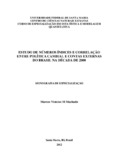| dc.contributor.advisor | Zanini, Roselaine Ruviaro | |
| dc.creator | Machado, Marcos Vinicios Machado | |
| dc.date.accessioned | 2017-05-29T13:52:38Z | |
| dc.date.available | 2017-05-29T13:52:38Z | |
| dc.date.issued | 2012-02-28 | |
| dc.date.submitted | 2012 | |
| dc.identifier.uri | http://repositorio.ufsm.br/handle/1/2958 | |
| dc.description | Monografia (especialização) - Universidade Federal de Santa Maria, Centro de Ciências Naturais e Exatas, Curso de Especialização em Estatística e Modelagem Quantitativa, RS, 2012. | por |
| dc.description.abstract | In this study, we tried to talk clearly and concisely on the use of indicators and indices and how they can be changed and updated over time relative to a base pre-established, as well as the study of Real Effective Exchange Rate and Brazilian trade balance, since the exchange rate policy is of utmost importance for the control of foreign accounts where their oscillations (surplus or deficit) may require action by the Government of adjustments in the economy. The main objective was to assess the magnitude of the correlation between the Real Effective Exchange Rate and Balance of Payments in the 2000s, using a methodology that unlike usual to calculate the Real Effective Exchange Rate employ up to 16 partners with greater trade exchange with Brazil, this work was chosen by the four largest in trade (U.S., Germany, China and Japan). That done, we attempted to observe the movement of foreign accounts in response to movement of the exchange rate during the first quarter of 2000 to fourth quarter of 2009 through a model uniequacional linear regression. We opted for simplified diagnostics focusing on four indicators / tests: the coefficient of determination, the t (and p-value) and the F statistic, the normality of the residuals. The dependent variables were tested individually: Exports, Imports, Balance of Payments, GDP and national income over the independent variable Real Effective Exchange Rate. It was observed from the results that the variations of exports, GDP and national income were strongly explained by the variation of the exchange rate, imports showed a variable degree of explanation median, the SBC has been poorly explained. The results showed that although we consider only the four largest trading partners the answers were expected signals with a high negative correlation was not observed apena to the Trade Balance. | eng |
| dc.language | por | por |
| dc.publisher | Universidade Federal de Santa Maria | por |
| dc.rights | Acesso Aberto | por |
| dc.subject | Indicadores | por |
| dc.subject | Índices | por |
| dc.subject | Contas externas | por |
| dc.subject | Regressão linear | por |
| dc.subject | Correlação | por |
| dc.title | Estudo de números índices e correlação entre política cambial e contas externas do Brasil na década de 2000 | por |
| dc.title.alternative | Study of correlation between number indices and external auditors and exchange rate policy in brazil decade 2000 | eng |
| dc.type | Trabalho de Conclusão de Curso de Especialização | por |
| dc.degree.local | Santa Maria, RS, Brasil. | por |
| dc.degree.specialization | Estatística e Modelagem Quantitativa | por |
| dc.description.resumo | Nesse trabalho, procurou-se discorrer de forma clara e concisa sobre a utilização de Indicadores e Índices e como podem ser transformados e atualizados ao longo do tempo em relação a uma base pré-estabelecida, assim como o estudo da Taxa de Câmbio Efetiva Real e a Balança Comercial brasileira, visto que a política cambial é de extrema importância para o controle das contas externas onde suas oscilações (superávit ou déficit) podem exigir por parte do Governo medidas de ajustes na economia. O principal objetivo foi verificar a magnitude da correlação entre a Taxa de Câmbio efetiva Real e o Saldo da Balança de Pagamentos na década de 2000, utilizando-se uma metodologia diferentemente da usual em que para calcular a Taxa de Câmbio Efetiva Real empregam-se os 16 parceiros com maior intercambio comercial com o Brasil, nesse trabalho optou-se pelos quatro com maiores comércio (EUA, Alemanha, China e Japão). Feito isso, buscou-se observar o movimento das contas externas em resposta ao movimento da taxa de câmbio no período do primeiro trimestre de 2000 até quarto trimestre de 2009 por meio de um modelo uniequacional de regressão linear. Optou-se por diagnósticos simplificados concentrando-se em quatro indicadores/testes: o coeficiente de determinação; o teste t (e o p-valor); a estatística F e; o teste de normalidade dos resíduos. As variáveis dependentes testadas individualmente foram: Exportação, Importação, Saldo da Balança de Pagamentos, PIB e Renda Nacional em relação à variável independente Taxa de Câmbio Efetiva Real. Observou-se pelos resultados que as variações das Exportações, PIB e Renda Nacional foram fortemente explicadas pela variação da taxa de cambio, a variável Importação apresentou um grau de explicação mediano, já o SBC foi fracamente explicado. Os resultados obtidos mostraram que, apesar se considerar apenas os quatros maiores parceiros, comerciais as respostas tiveram sinais esperados com uma elevada correlação negativa que não foi observada apena para o Saldo da Balança Comercial. | por |
| dc.publisher.unidade | Centro de Ciências Naturais e Exatas | por |


